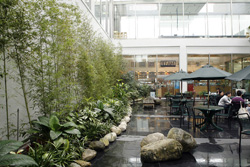

 Duet in the Courtyard is a multi-channel sound installation specially created for the Taipei Biennial. The artist recorded in advance the sound of visitors’ footsteps at a certain spot in the Taipei Fine Arts Museum’s open-air café, and then broadcast the recording through ten speakers placed at the original site.
Duet in the Courtyard is a multi-channel sound installation specially created for the Taipei Biennial. The artist recorded in advance the sound of visitors’ footsteps at a certain spot in the Taipei Fine Arts Museum’s open-air café, and then broadcast the recording through ten speakers placed at the original site.
The artist observes the corresponding relationship between people’s footsteps and space, and thus explores the meaning of the introduction of footsteps into a specific locale. The act of walking is always inherently purposeful. As someone goes to a certain place to do a certain thing, footsteps are perhaps only by-products that follow along, like a shadow. In addition to contacting the environment we pass through, they also emit sounds, which reflect the duality of the atmosphere of the surrounding environment and the emotions of the person who is walking. Duet in the Courtyard establishes TFAM as a special locale for collecting the sounds of footsteps. Museum visitors walk around, pass by artworks, pause, and then move on. They enter the café in the Court Garden, where there are no artworks, stop for a while, and depart. Among the different sounds of footsteps, some scattered, some complex, some slow, some brisk, meshing together like symphonic chords, there forms a collective interpretation of the relationship between people’s activities and a specific space. When the sound of real-life footsteps overlaps with the sound of recorded footsteps, this symbolizes a dialogue between the self that exists in reality and the other that exists in history. It all revolves around this specific locale, forming a cumulative experiential artifact. It neither is visible, nor exists in the form of an actual object. Yet it reverberates within a real space, stirring sensations and thoughts regarding the immediate locale.
Hong-Kai Wang’s creations consistently encompass such mixed media as sound and images. With faint ambiguity, she frequently expresses the overlapping relationships among motion, bearing, sound, time, place and culture, and how they influence one another in order to confirm the self-subjective position of each part.